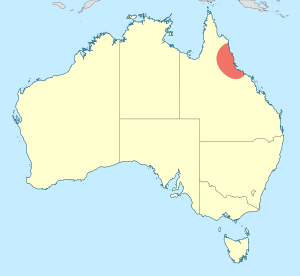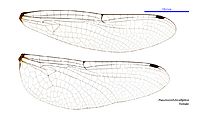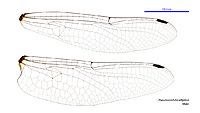Ellipse-tipped mistfly facts for kids
Quick facts for kids Ellipse-tipped mistfly |
|
|---|---|
| Conservation status | |
| Scientific classification | |
 |
The Pseudocordulia elliptica, also known as the ellipse-tipped mistfly, is a cool type of dragonfly. It belongs to the family Pseudocorduliidae. This dragonfly is medium-sized and has a shiny bronze-black body with clear, see-through wings.
You can only find the ellipse-tipped mistfly in one special place: the rainforest streams of north-eastern Queensland, Australia. When an animal or plant lives only in one specific area, we say it is endemic to that place.
Contents
Meet the Ellipse-Tipped Mistfly
The ellipse-tipped mistfly gets its name from its unique look. It's a type of insect that flies around streams in warm, wet places. These dragonflies are known for their strong flight and amazing eyesight.
What Does It Look Like?
This mistfly is a pretty striking insect. Its body is a dark, metallic bronze-black color, which helps it blend in with its forest home. Its wings are completely clear, like glass, and they shimmer in the sunlight as it flies.
Where Does It Live?
The ellipse-tipped mistfly loves to live near rainforest streams. These streams provide the perfect home for them. They need clean water for their young (called nymphs) to grow, and the surrounding rainforest offers plenty of places for the adult dragonflies to hunt for smaller insects.
Because it's endemic to north-eastern Queensland, Australia, you won't find this particular mistfly anywhere else in the world! This makes it a very special part of Australia's wildlife.
Dragonfly Families: A Little Mystery
Sometimes, scientists aren't completely sure which family a species belongs to. For the ellipse-tipped mistfly, there's a bit of a puzzle! Scientists are still figuring out if it best fits into the Pseudocorduliidae family, the Synthemistidae family, or the Corduliidae family. It's like trying to decide which sports team a player best fits on when they're good at many positions! This shows how science is always learning and discovering new things.
Gallery




